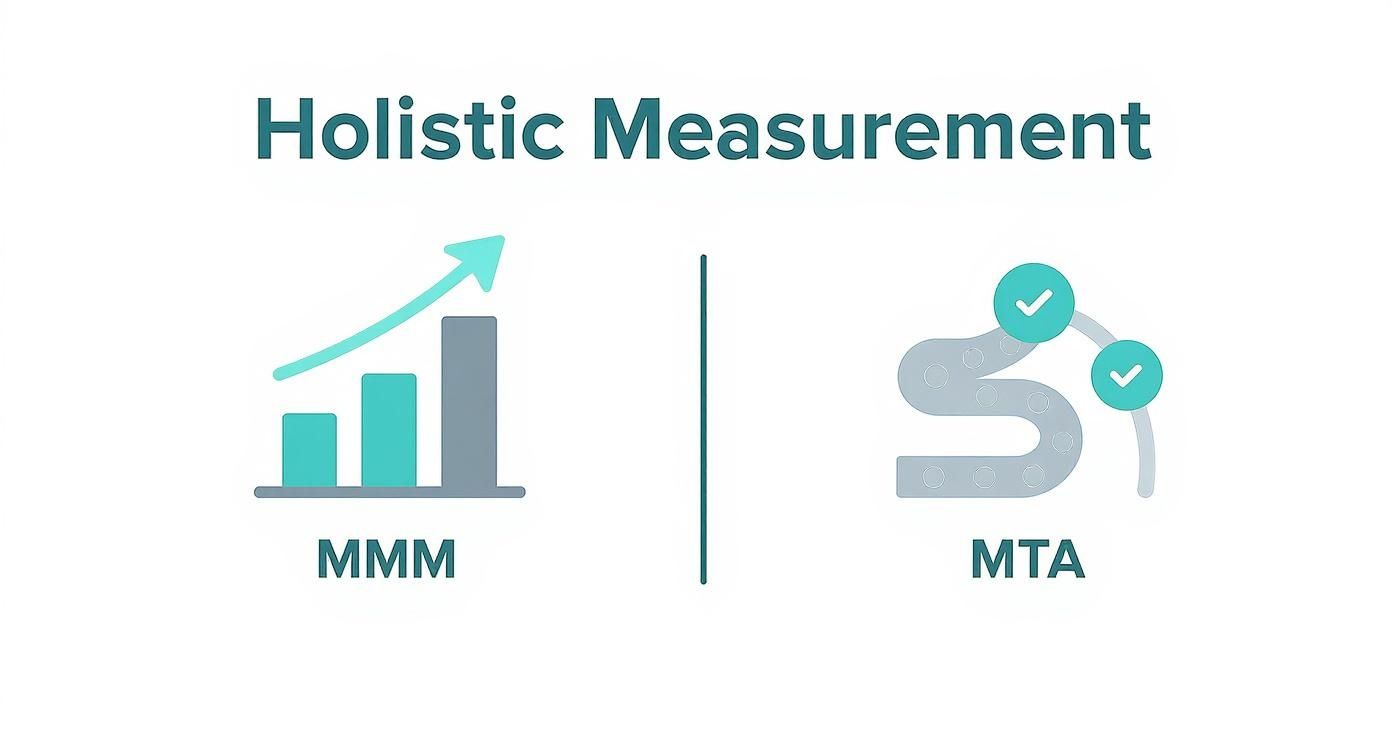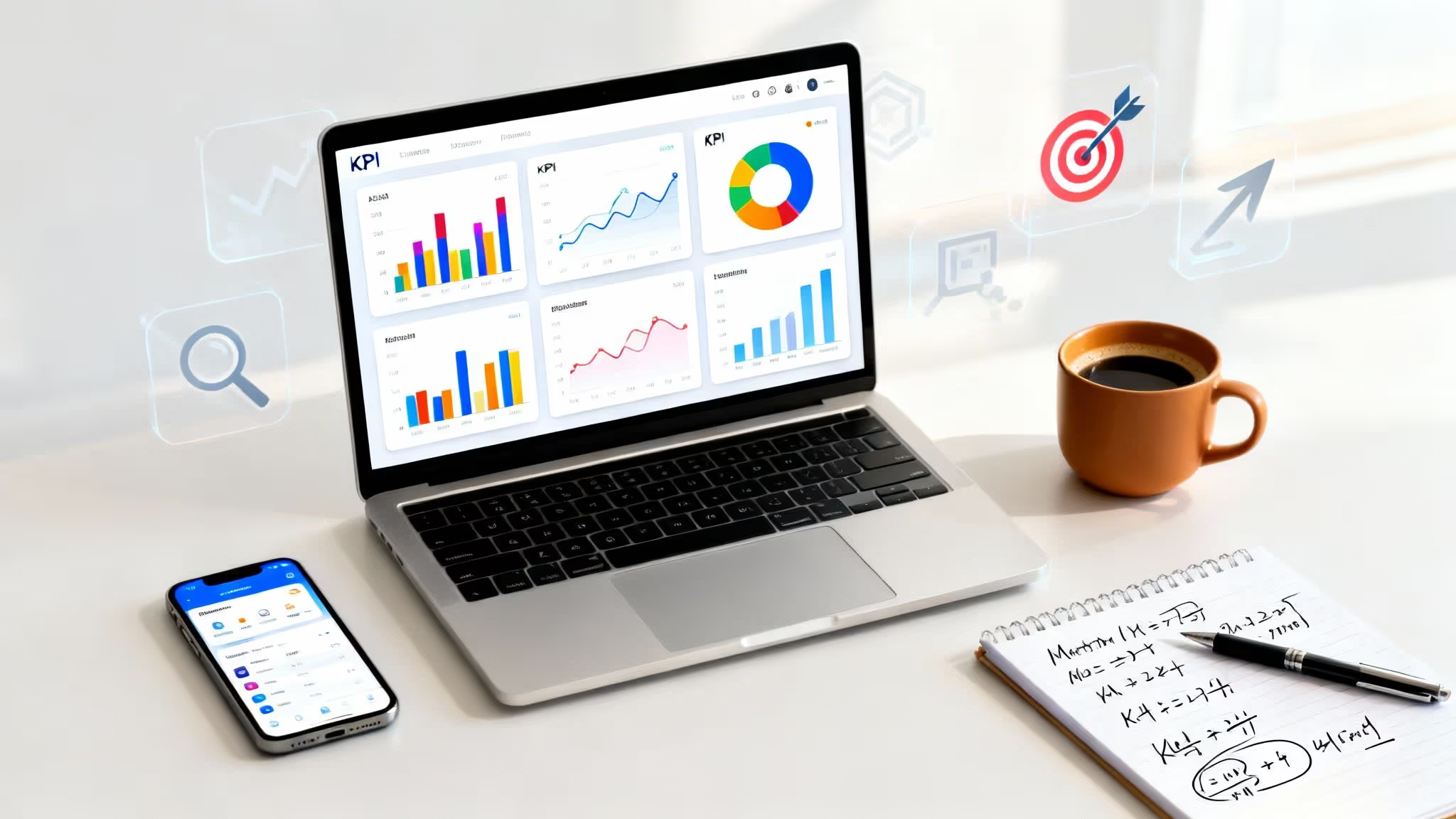Measuring marketing effectiveness is the crucial process of answering one simple question: "Is our marketing actually working?" It's about drawing a clear, undeniable line from your campaigns to tangible business results, such as increased revenue or customer growth. This means moving beyond vanity metrics like likes and clicks to understand the true impact on your bottom line.
Beyond Clicks: The Truth About Marketing Effectiveness
Let's be direct: likes and clicks don’t pay the bills. While they can signal engagement, they rarely tell the full story of your marketing's value. True success is measured by connecting every dollar spent on a campaign to a demonstrable business outcome.
Think of your measurement strategy like a ship's navigation system. Relying only on clicks is like staring at the speedometer—it tells you you're moving, but says nothing about your direction. To truly measure marketing effectiveness, you need a comprehensive dashboard of instruments to chart a course toward your most important goals.
The Real Goals of Measurement
Effective measurement isn't just about justifying your budget; it's a strategic tool for continuous improvement. The primary objectives are straightforward:
- Demonstrate Value: Clearly show how marketing contributes to revenue, customer acquisition, and overall brand health.
- Optimize Spending: Identify which channels and campaigns deliver the best returns, allowing you to invest your resources more wisely.
- Understand Customers: Gain deeper insights into the customer journey and pinpoint the touchpoints that genuinely influence purchasing decisions.
- Drive Growth: Make data-backed decisions that fuel sustainable growth, rather than chasing short-term, superficial metrics.
This process addresses the modern marketer's greatest challenge: proving value when the customer journey is fragmented across numerous platforms. Without a robust measurement framework, even your best efforts can get lost in the noise. For a head start, explore the key digital marketing performance metrics in our detailed guide.
The ultimate goal is to shift from justifying expenses to strategically investing in growth. Effective measurement empowers marketers to speak the language of the C-suite—the language of ROI, customer lifetime value, and market share.
Navigating the Modern Marketing Maze
The path from initial interest to final purchase is rarely linear. A customer might see a social media ad on Monday, read a blog post on Wednesday, open an email on Friday, and then click a search ad to complete the transaction over the weekend.
Each of these touchpoints played a role, and effective measurement helps you assign the appropriate credit to each one.
This guide will take you beyond surface-level data and into the core of what truly effective measurement looks like. We’ll provide a clear roadmap to understanding and demonstrating your real-world impact, arming you with the tools to prove that marketing isn’t an expense—it's a powerful engine for growth.
The Core Metrics That Actually Matter

It’s easy to feel overwhelmed by data. Modern marketing platforms generate a flood of numbers, but measuring marketing effectiveness isn't about tracking everything. It's about focusing on the metrics that provide a clear, honest picture of performance.
To cut through the noise, organize your most important Key Performance Indicators (KPIs) into three distinct categories. Think of them as the three legs of a stool—each is essential for a stable, comprehensive view of your marketing performance.
- Financial Impact: These metrics directly link your marketing spend to revenue.
- Customer Acquisition: These indicators measure the efficiency and sustainability of your growth.
- Brand Health: These long-term signals gauge customer loyalty and market presence.
By structuring your measurement this way, you move beyond collecting isolated data points and begin to build a compelling narrative about your marketing's true value.
Financial Impact Metrics
Ultimately, marketing must contribute to the bottom line. Financial metrics are non-negotiable because they communicate value in terms the C-suite understands. The two most critical metrics here are Return on Investment (ROI) and Return on Ad Spend (ROAS).
Return on Investment (ROI) is your comprehensive profitability score. It accounts for all associated costs—ad spend, creative development, software, and even salaries—to measure the net profit generated. It is the definitive grade on your marketing report card.
Return on Ad Spend (ROAS), in contrast, is more specific. It focuses solely on the gross revenue generated for every dollar spent on advertising. This makes it an ideal tool for evaluating the performance of individual campaigns, such as a Google Ads or Facebook initiative. While ROI assesses overall strategy, ROAS helps you optimize specific tactics. For a closer look, you can learn how to calculate Return on Ad Spend in our guide.
Customer Acquisition Efficiency
Acquiring new customers is essential. Acquiring them profitably is what builds a sustainable business. To monitor this, you must track two interconnected metrics: Customer Acquisition Cost (CAC) and Customer Lifetime Value (CLV).
Customer Acquisition Cost (CAC) is elegantly simple: it calculates the average cost to acquire a single new customer. To find it, sum all your sales and marketing expenses over a given period and divide by the number of new customers acquired.
However, CAC tells only half the story. The other, arguably more important, part is Customer Lifetime Value (CLV). This metric forecasts the total revenue a business can reasonably expect from a single customer account throughout their relationship with the brand.
The real insight comes from comparing these two metrics. For a business to be viable, its CLV must be significantly higher than its CAC. The industry benchmark for a healthy business is a CLV:CAC ratio of 3:1—meaning for every dollar you spend to acquire a customer, you generate three dollars in return over their lifetime.
Long-Term Brand Health
While financial and acquisition metrics focus on immediate results, brand health metrics are forward-looking indicators of long-term success. They may seem "softer," but they are powerful predictors of sustainable growth and market resilience.
A classic metric is the Net Promoter Score (NPS). It gets straight to the point by asking one simple question: "On a scale of 0-10, how likely are you to recommend our brand to a friend or colleague?" The responses immediately reveal your most enthusiastic advocates (Promoters) and those at risk of spreading negative feedback (Detractors), providing a valuable snapshot of customer sentiment.
Another vital sign of brand health is Share of Voice (SOV). This metric measures your brand's portion of the conversation within your industry compared to competitors. By tracking mentions across social media, forums, and news outlets, you can gauge your brand’s visibility, which often correlates directly with market share.
Navigating Modern Measurement Challenges
The landscape of marketing measurement is undergoing a seismic shift. Familiar tools we once relied on for measuring marketing effectiveness, like third-party cookies, are disappearing, while new privacy regulations like GDPR are redrawing the boundaries. These are not minor hurdles; they are fundamental changes that render many traditional tracking methods obsolete.
This new reality is forcing a necessary evolution in analytics. The customer journey is now fragmented across countless devices and platforms, and attempting to piece it together with simple, linear tracking is no longer sufficient. It's like trying to follow a single conversation happening across a dozen different rooms at once—you only catch fragments.
The Crumbling Cookie And The Privacy Pivot
For years, the third-party cookie was the backbone of digital advertising, enabling brands to track user behavior across the web for personalization and ad targeting. Its gradual phase-out marks the end of an era. With over 80% of marketers having reported a heavy reliance on these cookies, the disruption is significant.
However, this is not a crisis—it's a catalyst for better marketing. We are moving toward a more transparent, consent-based model. This pivot requires a change in mindset, compelling us to build direct relationships with customers and rely on first-party data they willingly provide.
This shift away from third-party tracking isn't about losing visibility; it's about earning it. Marketers who prioritize trust and provide genuine value in exchange for data will build more resilient, loyal customer relationships in a privacy-first world.
Embracing Unified Marketing Measurement
To navigate these challenges, forward-thinking teams are adopting a more sophisticated approach known as unified marketing measurement. According to experts at WARC.com, this is a key trend for 2025 and beyond, as marketers strive for a holistic view of their impact. This strategy integrates multiple data sources and methodologies, moving beyond siloed metrics to accurately map customer journeys across a complex media ecosystem.
Think of it like a detective solving a complex case. A single piece of evidence is rarely enough. A skilled detective gathers DNA, cross-references witness statements, and analyzes security footage to build an undeniable case. Unified measurement does the same for marketing.
It works by blending different models to create a complete performance picture:
- Marketing Mix Modeling (MMM): This is your "top-down" perspective. It analyzes how high-level factors like ad spend, seasonality, and economic trends influence overall sales.
- Attribution Modeling: This is the "bottom-up" analysis. It examines individual customer journeys to assign credit to specific touchpoints. You can get a much deeper look into what is multi-touch attribution in our comprehensive guide.
- Incrementality Testing: These are controlled experiments, like A/B tests, designed to isolate the true causal impact of a specific campaign or channel. Did that ad actually cause the sale, or would it have occurred anyway?
By weaving these different threads together, you can finally see both the forest and the trees. This holistic approach empowers you to answer big-picture strategic questions while fine-tuning the tactical details of your campaigns—the key to navigating the modern measurement landscape with confidence.
Powerful Frameworks For Holistic Measurement
Connecting marketing efforts to business outcomes requires more than tracking a few isolated metrics. To understand the complete story, you need a framework. Think of it as using both a telescope and a microscope to study the stars—each provides a different yet equally vital perspective.
Two of the most trusted frameworks for measuring marketing effectiveness are Marketing Mix Modeling (MMM) and Multi-Touch Attribution (MTA). Understanding how they work, both independently and together, is key to making smarter, data-driven decisions in a complex marketing environment.
The Big Picture View With Marketing Mix Modeling
Think of Marketing Mix Modeling (MMM) as your strategic, top-down view—a satellite image of your entire marketing ecosystem. This statistical method analyzes historical data—sales figures, ad spend across channels, seasonality, and even economic trends—to reveal the big-picture impact of each marketing lever over time.
Because MMM does not rely on individual user tracking or cookies, it has become invaluable in our privacy-first era. It is ideal for answering high-level questions like, "What was the overall ROI of our TV advertising last quarter?" or "How much did our PR initiatives contribute to sales?"
MMM helps you understand the incremental lift from each channel, allowing for smarter, long-term budget allocation. It’s less about a single customer click and more about the combined force of your entire marketing strategy.
And MMM continues to evolve. As brands increasingly focus on social responsibility, these frameworks are expanding to measure the impact of these values. Marketing Mix Modeling is set to incorporate non-traditional metrics tied to purpose-driven goals, quantifying how sustainability and diversity campaigns influence brand performance. This signals a shift toward a multi-dimensional view of marketing that extends beyond pure revenue. You can read more about these trends in the latest insights on marketing effectiveness measurement.
The Granular Journey With Multi-Touch Attribution
If MMM provides the satellite view, then Multi-Touch Attribution (MTA) is the street-level map. It meticulously traces the specific path a customer takes on their way to a purchase. This bottom-up approach assigns credit to the individual touchpoints along that journey, from the first social media ad they saw to the final email they clicked.
This granular detail is invaluable for tactical optimization. By knowing which touchpoints carry the most weight, you can adjust your campaigns in near real-time. For a deeper dive into the mechanics, check out our complete article on what marketing attribution is and how it works.
Several common MTA models distribute credit differently:
- Linear Model: This model gives equal credit to every touchpoint. It’s simple but can understate the impact of more decisive interactions.
- Time-Decay Model: Here, touchpoints closer to the conversion receive more credit, based on the assumption that more recent interactions were more influential.
- U-Shaped Model: This model assigns the most credit to the first touch (for creating awareness) and the last touch (for closing the deal), with the interactions in the middle sharing the rest.
The visual below illustrates how these top-down (MMM) and bottom-up (MTA) approaches provide two different but complementary perspectives.

As you can see, MMM provides a high-level, strategic overview, while MTA delivers a detailed, journey-specific analysis.
The Rise Of Hybrid Models
Let's be clear: neither MMM nor MTA is a silver bullet. MMM can be slow and lacks granularity, while MTA faces challenges with the demise of third-party cookies and struggles to measure offline channels. That’s why the future of measurement lies in hybrid models.
These advanced approaches integrate the strengths of both frameworks. They use MMM to set the overarching strategic budget and understand macro trends, then deploy MTA to optimize tactics within those channels. This unified view offers the best of both worlds, providing a robust and adaptable system for measuring your marketing effectiveness with confidence.
Using Data For Smarter Budget Allocation

Gathering data is just the beginning. The real value is realized when you transform those numbers into intelligent action. When measurement is done right, your marketing budget evolves from a static line item into a dynamic, performance-driven tool for growth.
The goal is to shift resources to the channels and campaigns that demonstrably deliver results, rather than relying on intuition or industry trends. This approach empowers you to take control. Once you identify which channels attract your most valuable customers, you can confidently reallocate funds to maximize your impact.
The Dangers Of Inconsistent Spend
During economic uncertainty, marketing budgets are often the first to be cut. However, reducing spend without solid data is a significant gamble. The knee-jerk reaction to pause advertising may offer short-term savings, but it can inflict serious long-term damage on revenue and brand recognition.
Data-driven decisions are your best defense. Recent findings from Nielsen highlight the financial cost of pulling back. Their research shows that brands lose an average of 2% of future revenue for every quarter they halt advertising. Conversely, even a modest 1-point gain in brand health can lead to a 1% increase in sales, proving the direct link between visibility and profitability. You can find more details in Nielsen's report on maximizing marketing effectiveness.
The goal is to build a culture of continuous testing and optimization. Your budget should flow intelligently to the activities that generate the greatest return, creating a powerful feedback loop of investment and growth.
This principle is at the core of evaluating ROI in digital marketing, ensuring every dollar spent works as hard as possible to achieve your business goals.
Uncovering Hidden Opportunities
One of the most rewarding aspects of rigorous measurement is discovering high-performing channels that others may overlook. While conventional wisdom has its place, your data may tell a different—and far more profitable—story.
For example, your analysis might reveal that sponsoring a niche podcast attracts leads with a much higher Customer Lifetime Value (CLV) than your high-profile social media campaigns. Or perhaps a traditional billboard, tracked with a simple QR code, is driving more qualified traffic to your website than you anticipated.
These are the insights that create a true competitive advantage. They aren't found by accident; they require a commitment to ongoing evaluation:
- Test Emerging Channels: Allocate a small, experimental portion of your budget to new or unconventional channels to test their potential.
- Analyze Full-Funnel Impact: Look beyond last-click attribution. Examine how top-of-funnel activities, like your blog or brand campaigns, contribute to final conversions.
- Segment Your Performance Data: Analyze your data from multiple angles. Compare how different channels perform for various customer segments to identify high-value audiences.
By consistently analyzing performance and reallocating your budget based on hard evidence, you ensure your marketing strategy remains agile, efficient, and aligned with your growth objectives. This transforms measuring marketing effectiveness from a reporting task into a strategic engine for success.
Your Action Plan for Effective Measurement
Understanding the theory is one thing; putting it into practice is what drives business growth. Ultimately, success in measuring marketing effectiveness comes from a disciplined, systematic approach, not from chasing the latest trend. This action plan synthesizes everything we've discussed into a clear, repeatable process.
The first step is always to anchor your measurement strategy to your high-level business goals. Don't start with metrics; start with what the business needs to achieve. Is the objective to capture more market share? Increase Q4 revenue by 15%? Or improve customer retention? These top-tier goals will dictate every subsequent decision.
With that clarity, you can select Key Performance Indicators (KPIs) that directly map to those objectives. If revenue growth is paramount, Customer Acquisition Cost (CAC) and Customer Lifetime Value (CLV) are your north stars. If you’re focused on building brand awareness, you'll concentrate on metrics like Share of Voice (SOV) and brand recall.
Building Your Measurement Engine
With your goals and KPIs defined, it's time to choose the right tools and frameworks. You don't need a complex Marketing Mix Model on day one. Your choice should align with your company’s size, industry, and the specific questions you need to answer.
- For Startups and SMBs: Master the fundamentals. Ensure Google Analytics 4 is properly configured, use UTM parameters consistently across all campaigns, and track conversions diligently, even if it’s in a simple spreadsheet or CRM. Your primary focus should be on channel-level ROAS and CAC.
- For Growing Companies: This is the stage to explore more sophisticated attribution. A U-shaped or time-decay model will provide far greater insight into the customer journey than last-click analysis alone.
- For Enterprises: At this scale, hybrid models are essential. You'll want to combine the strategic, big-picture view from MMM with the granular, tactical details from MTA to achieve a complete performance picture.
Regardless of your company’s size, a centralized data dashboard is non-negotiable. Consolidating your key metrics into one visual location—whether it’s Google Data Studio, a CRM dashboard, or a specialized BI tool—makes insights accessible to everyone and helps foster a data-first culture.
Remember, measuring marketing effectiveness is not a one-time project; it is an ongoing discipline. It requires a commitment to continuous learning, testing, and optimization.
When you adopt this mindset, your role evolves. You transition from a marketer justifying spend to a strategic leader who uses data to guide the entire organization toward predictable, sustainable growth.
Frequently Asked Questions
Even with a solid plan, questions are bound to arise as you delve into the data. Let’s address some of the most common ones to help you move forward with confidence.
How Often Should I Measure Marketing Effectiveness?
The honest answer is that it depends on the metric. You wouldn't measure a tree's height daily, but you would regularly check for signs of disease. The same principle applies here.
- Strategic KPIs: For big-picture metrics like Customer Lifetime Value (CLV) or brand health, which evolve slowly, a quarterly review is sufficient to track long-term trends.
- Tactical Metrics: For metrics like Return on Ad Spend (ROAS) on a digital campaign, more frequent monitoring is necessary. Check in weekly, or even daily during a major launch, to allow for rapid adjustments.
The key is to establish a reporting cadence that aligns with your business cycles, providing actionable insights rather than just a mountain of data.
What Are The First Steps For A Small Business?
If you're just starting, prioritize simplicity. Your greatest advantage is agility, so focus on foundational practices that provide immediate feedback without requiring a complex technology stack.
First, ensure Google Analytics 4 is installed correctly. This is your baseline for understanding website traffic and user behavior.
Next, select just 2-3 critical KPIs that tie directly to your business goals, such as lead form submissions or completed sales. Then, begin using UTM parameters on all your campaigns. This simple habit of tagging your links will provide immense clarity on which channels are performing.
By concentrating on basics like Customer Acquisition Cost (CAC) and the conversion rate for each channel, you will build a powerful, foundational understanding of what works.
How Do I Measure The Effectiveness Of Offline Marketing?
Measuring offline efforts like print ads or event sponsorships requires some creativity to bridge the gap to the digital world, but it's entirely feasible.
The simplest method is to use unique vanity URLs, dedicated phone numbers, or QR codes that direct users to a specific landing page. This allows you to track exactly how many people responded to that specific offline ad. From there, you can monitor those leads in your CRM to see how many converted into customers.
Another effective tactic is to run a simple post-purchase survey asking, "How did you hear about us?" While not perfectly scientific, this directional data is invaluable. It can even be incorporated into a broader Marketing Mix Model later on to provide a more complete picture.
At Twelverays, we turn complex data into clear, actionable strategies that actually grow your business. If you're ready to move beyond guesswork, let's talk about what our data-driven digital marketing and CRM solutions can do for you. Learn more about how Twelverays can elevate your marketing effectiveness.





